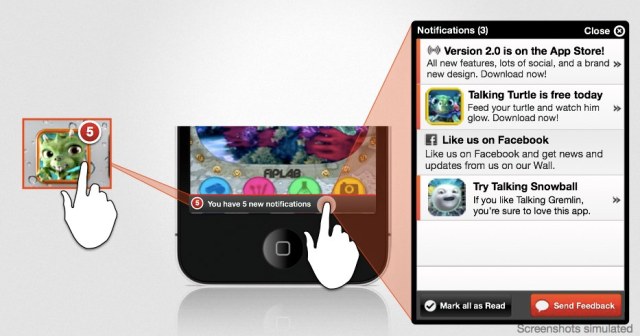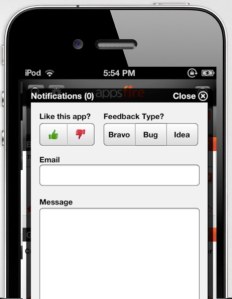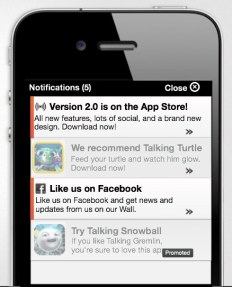Today, mobile promotion and discovery service AppsFire is launching a new toolkit for developers called App Booster. Meant to boost user engagement and retention, two of the toughest challenges developers face today, the App Booster SDK (software development kit) introduces a suite of tools for things like in-app notifications, user feedback, analytics and mobile app cross-promotion.
According to AppsFire co-founder Ouriel Ohayon, mobile app engagement is not optimal today because developers don’t have relationships with their users. In addition, because apps are these walled off, sandboxed pieces of software, they’re often forgotten soon after download.
Push notifications, like those powered by Urban Airship, for example, can help address some of these issues, but they only work for users who agree to accept the notifications to begin with. Many don’t. Ohayon says that these notifications are only activated around 50% of the time – a figure that hints at users’ growing resistance to these interruptive type of alerts. It’s something that’s likely a function of the increased number of apps users have installed on their phones. The average smartphone user has over 60 apps today, and, let’s face it, not all developers have used push responsibly. The better option lately (especially when you’re just testing a new app), is to say “no” to the “allow push notifications?” message.
App Booster presents an alternative that can re-target those non-push users, in the form of in-app notifications. These are different from push, as pop-up messages aren’t involved, nor do they clutter the phone’s notification center. However, the in-app notifications can trigger the bubble on the icon of the app and appear in a News Feed-like way within the app.

Here, the developer can communicate with their users as much as they like, posting welcome messages to newbies, offering app tips, communicating about updates and changes, and attempt to re-opt in users who didn’t accept push notifications initially.
 Developers can also solicit feedback and ratings from their users, something that has typically come in the form of a push message: “do you want to rate this app?” – again feeling more like an annoyance than a feature. App Booster’s in-app feedback system is structured differently, however, allowing users to submit different types of feedback, like bugs and ideas, alongside their review. And when the user leaves the feedback, the system re-routes automatically to the iTunes App Store or Android Market to post the review.
Developers can also solicit feedback and ratings from their users, something that has typically come in the form of a push message: “do you want to rate this app?” – again feeling more like an annoyance than a feature. App Booster’s in-app feedback system is structured differently, however, allowing users to submit different types of feedback, like bugs and ideas, alongside their review. And when the user leaves the feedback, the system re-routes automatically to the iTunes App Store or Android Market to post the review.
On the backend, App Booster provides a web dashboard for tracking engagement analytics, plus creating and targeting the in-app notifications. The latter can be filtered by geography, language, app version or OS version. Developers can also cross-promote their apps, or arrange free barter programs with other developers via the SDK.
In early tests, the company has seen engagement improvements of up to 50% and CTRs from 15% to 50%. It will be interesting to see what numbers a broader rollout provides. After all, many app users have become blind to red badges too. Will apps really be launched more? Or will it just be that those apps that are already popular will now have an improved way to enable developer-user communication?
Besides, it’s just as possible that the best feature in the toolkit turns out to be the less intrusive way it pushes users to leave app reviews. More reviews of a positive nature will in turn lead to better app store rankings, and that leads to more downloads.
But for now, the in-app notification center is the SDK’s top draw. Ohayon notes that many of the biggest apps (e.g., Facebook) have built their own notification systems, but it’s very hard for developers to create something like that for themselves. The App Booster toolkit, for example, has been in development for 8 months and still isn’t done.
Currently, the SDK is available for iOS and Android, and will arrive soon for HTML5 apps. It’s available as a free download here.
Source:http://techcrunch.com/2012/02/07/want-an-in-app-notification-center-theres-a-sdk-for-that/
According to AppsFire co-founder Ouriel Ohayon, mobile app engagement is not optimal today because developers don’t have relationships with their users. In addition, because apps are these walled off, sandboxed pieces of software, they’re often forgotten soon after download.
Push notifications, like those powered by Urban Airship, for example, can help address some of these issues, but they only work for users who agree to accept the notifications to begin with. Many don’t. Ohayon says that these notifications are only activated around 50% of the time – a figure that hints at users’ growing resistance to these interruptive type of alerts. It’s something that’s likely a function of the increased number of apps users have installed on their phones. The average smartphone user has over 60 apps today, and, let’s face it, not all developers have used push responsibly. The better option lately (especially when you’re just testing a new app), is to say “no” to the “allow push notifications?” message.
App Booster presents an alternative that can re-target those non-push users, in the form of in-app notifications. These are different from push, as pop-up messages aren’t involved, nor do they clutter the phone’s notification center. However, the in-app notifications can trigger the bubble on the icon of the app and appear in a News Feed-like way within the app.

Here, the developer can communicate with their users as much as they like, posting welcome messages to newbies, offering app tips, communicating about updates and changes, and attempt to re-opt in users who didn’t accept push notifications initially.
 Developers can also solicit feedback and ratings from their users, something that has typically come in the form of a push message: “do you want to rate this app?” – again feeling more like an annoyance than a feature. App Booster’s in-app feedback system is structured differently, however, allowing users to submit different types of feedback, like bugs and ideas, alongside their review. And when the user leaves the feedback, the system re-routes automatically to the iTunes App Store or Android Market to post the review.
Developers can also solicit feedback and ratings from their users, something that has typically come in the form of a push message: “do you want to rate this app?” – again feeling more like an annoyance than a feature. App Booster’s in-app feedback system is structured differently, however, allowing users to submit different types of feedback, like bugs and ideas, alongside their review. And when the user leaves the feedback, the system re-routes automatically to the iTunes App Store or Android Market to post the review.On the backend, App Booster provides a web dashboard for tracking engagement analytics, plus creating and targeting the in-app notifications. The latter can be filtered by geography, language, app version or OS version. Developers can also cross-promote their apps, or arrange free barter programs with other developers via the SDK.
In early tests, the company has seen engagement improvements of up to 50% and CTRs from 15% to 50%. It will be interesting to see what numbers a broader rollout provides. After all, many app users have become blind to red badges too. Will apps really be launched more? Or will it just be that those apps that are already popular will now have an improved way to enable developer-user communication?
Besides, it’s just as possible that the best feature in the toolkit turns out to be the less intrusive way it pushes users to leave app reviews. More reviews of a positive nature will in turn lead to better app store rankings, and that leads to more downloads.
But for now, the in-app notification center is the SDK’s top draw. Ohayon notes that many of the biggest apps (e.g., Facebook) have built their own notification systems, but it’s very hard for developers to create something like that for themselves. The App Booster toolkit, for example, has been in development for 8 months and still isn’t done.
Currently, the SDK is available for iOS and Android, and will arrive soon for HTML5 apps. It’s available as a free download here.
Source:http://techcrunch.com/2012/02/07/want-an-in-app-notification-center-theres-a-sdk-for-that/


Thanks for posting this helpful post on in app notification, I got all the details about amp from here.
ReplyDelete